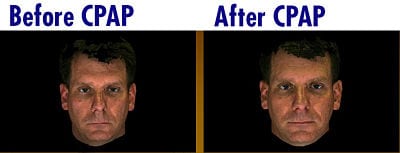Treating sleep apnea can do more than improve sleep quality. It may also help people look better, new research shows.
The study, published in the Journal of Clinical Sleep Medicine, adds to a growing body of evidence linking sleep and beauty.
Researchers out of the University of Michigan Health System and Michigan Technological University in Ann Arbor showed that there was a specific improvement in facial appearance after at-home treatment for sleep apnea with CPAP.
“The common lore, that people ‘look sleepy’ because they are sleepy, and that they have puffy eyes with dark circles under them, drives people to spend untold dollars on home remedies,” says Ronald Chervin, MD, MS, director of the U-M Sleep Disorders Center and the Michael S. Aldrich Collegiate Professor of Sleep Medicine and professor of Neurology at the U-M Medical School, in a news release. “We perceived that our CPAP patients often looked better, or reported that they’d been told they looked better, after treatment. But no one has ever actually studied this.”

Together with U-M plastic and reconstructive surgeon Steven Buchman, MD, the team used photogrammetry to take an array of images of the 20 middle-aged men under identical conditions before CPAP and a few months after. “One of the breakthroughs in plastic surgery over the last decade has been our aim to get more objective in our outcomes,” Buchman says. “The technology used in this study demonstrates the real relationship between how you look and how you really are doing, from a health perspective.”
Study Results Highlight Objective Changes in Attractiveness
The research team also included experts who developed a way to precisely map the colors of patients’ facial skin before and after CPAP treatment. The researchers also used a subjective test of appearance: 22 independent raters were asked to look at the photos, without knowing which were the “before” pictures and which the “after” pictures of each patient. The raters were asked to rank attractiveness, alertness, and youthfulness, and pick which picture they thought showed the patient after sleep apnea treatment.
About two-thirds of the time, the raters stated that the patients in the post-treatment photos looked more alert, more youthful, and more attractive. The raters also correctly identified the post-treatment photo two-thirds of the time, the study showed.
Moreover, the objective measures of facial appearance showed that patients’ foreheads were less puffy, and their faces were less red, after CPAP treatment. The redness reduction was especially visible in 16 Caucasian patients and was associated with the independent raters’ tendency to say a patient looked more alert in the post-treatment photo.
The researchers also perceived, but did not have a way to measure, a reduction in forehead wrinkles after treatment. There were no changes in attributes typically associated with being tired, such as dark blue circles or puffiness under the eyes.


